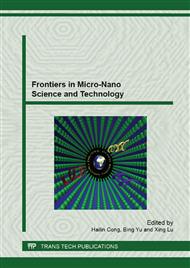[1]
C. J. Sandroff, R. N. Nottenburg, J.C. Bischoff, and R. Bhat, Dramatic enhancement in the gain of a GaAs/AlGaAs heterostructure bipolar transistor by surface chemical passivation, Appl. Phys. Lett. 51, (1987) 33-35.
DOI: 10.1063/1.98877
Google Scholar
[2]
R. Iyer, R. R. Chang, and D. L. Lile, Sulfur as a surface passivation for InP, Appl. Phys. Lett. 53 (1988) 134-136.
DOI: 10.1063/1.100575
Google Scholar
[3]
Min Xu, Jiangjiang J. Gu, Chen Wang D.M. Zhernokletov R.M. Wallace et al, New insights in the passivation of high-k/InP through interface characterization and metal oxide semiconductor field effect transistor demonstration: Impact of crystal orientation, Appl. Phys. Lett. 113 (2013).
DOI: 10.1063/1.4772944
Google Scholar
[4]
SangHyeon Kim, Masafumi Yokoyama, Noriyuki Taoka, Ryo Iida et al, Self-aligned metal source/drain InP n-metal-oxide-semiconductor field-effect transistors using Ni–InP metallic alloy, Appl. Phys. Lett. 98 (2011) 243501-1.
DOI: 10.1063/1.3597228
Google Scholar
[5]
Christoph Adelmann, Daniel Cuypers, Massimo Tallarida et al, Surface Chemistry and Interface Formation during the Atomic Layer Deposition of Alumina from Trimethyl Aluminum and Water on Indium Phosphide, Chem. Mater, Publication Date (Web): 18 Feb (2013).
DOI: 10.1021/cm304070h
Google Scholar
[6]
Bo Wang, Zhipeng Wei, Mei Li, et al, Tailoring the photoluminescence characteristics of p-type GaSb: The role of surface chemical passivation. Chemical Physics Letters. 556 (2013) 182-187.
DOI: 10.1016/j.cplett.2012.11.041
Google Scholar
[7]
Shanshan Tian, Zhi peng Wei, Yongfeng Li et al, Materials Science in semiconductor Processing, MSSP-D-13-00127, revise.
Google Scholar
[8]
W.D. Chen X.Q. Li,L.H. Duan, X.L. Xie Y.D. Cui, Photoluminescence enhancement of (NH4)2Sx passivated InP surface by rapid thermal annealing, Applied Surface Science. lOO/lOl (1996) 592-595.
DOI: 10.1016/0169-4332(96)00345-5
Google Scholar
[9]
C. W. Wilmsen, K. M. Geib, J. Shin, R. Iyer, D. L. Lile et al. The sulfurized InP surface, J. Vac. Sci. Technol. B. 7 (1989) 851-853.
Google Scholar
[10]
I. K. Han, E. K. Kim, J. I. Lee, S. H. Kim, and K. N. Kang, Stability of sulfur-treated InP surface studied by photoluminescence and x-ray photoelectron spectroscopy, J. Appl. Phys. 81 (1997) 6986-6991.
DOI: 10.1063/1.365263
Google Scholar
[11]
K. Sata and H. Ikoma, Internal Photoemission and X-Ray Photoelectron Spectroscopic Studies of Sulfur-Passivated GaAs, Jpn. J. Appl. Phys. 32 (1993) 921-929.
DOI: 10.1143/jjap.32.921
Google Scholar
[12]
Z. S. Li, X. Y. Hou, W. Z. Cai et al, A mild electrochemical sulfur passivation method for GaAs(100) surfaces, J. Appl. Phys. 78 (1995) 2764-2766.
DOI: 10.1063/1.360074
Google Scholar
[13]
Z. Chen, W. Kim, A. Salvador et al, Schottky barriers on anodic sulfide passivated GaAs and their stability J. Appl. Phys. 78 (1995) 3920-3925.
DOI: 10.1063/1.359910
Google Scholar
[14]
Y. Tao, A. Yelon, E. Sacher, Z. H. Lu, and M. J. Graham, S passivated InP (100)(1×1) surface prepared by a wet chemical process, Appl. Phys. Lett. 60 (1992) 2669-2671.
DOI: 10.1063/1.106890
Google Scholar
[15]
W. M. Lau, S. Jin, X. -W. Wu, and S. Ingrey, In situ x‐ray photoelectron spectroscopic study of remote plasma enhanced chemical vapor deposition of silicon nitride on sulfide passivated InP J. Vac. Sci. Technol. B8 (1990) 848-892.
DOI: 10.1116/1.584977
Google Scholar


